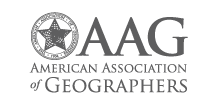
A geographer is a physical scientist, social scientist or humanist whose area of study is geography, the study of Earth's natural environment and human society, including how society and nature interacts. The Greek prefix "geo" means "earth" and the Greek suffix, "graphy", meaning "description", so a geographer is someone who studies the earth. The word "geography" is a Middle French word that is believed to have been first used in 1540.
Toponymy, toponymics, or toponomastics is the study of toponyms, including their origins, meanings, usage and types. Toponym is the general term for a proper name of any geographical feature, and full scope of the term also includes proper names of all cosmographical features.

A subregion is a part of a larger region or continent. Cardinal directions are commonly used to define subregions.
Feminist geography is a sub-discipline of human geography that applies the theories, methods, and critiques of feminism to the study of the human environment, society, and geographical space. Feminist geography emerged in the 1970s, when members of the women's movement called on academia to include women as both producers and subjects of academic work. Feminist geographers aim to incorporate positions of race, class, ability, and sexuality into the study of geography. The discipline has been subject to several controversies.

The International Geographical Union is an international geographical society. The first International Geographical Congress was held in Antwerp in 1871. Subsequent meetings led to the establishment of the permanent organization in Brussels, Belgium, in 1922.

The American Association of Geographers (AAG) is a non-profit scientific and educational society aimed at advancing the understanding, study, and importance of geography and related fields. Its headquarters is located in Washington, D.C. The organization was founded on December 29, 1904, in Philadelphia, as the Association of American Geographers, with the American Society of Professional Geographers later amalgamating into it in December 1948 in Madison, Wisconsin. As of 2020, the association has more than 10,000 members, from nearly 100 countries. AAG members are geographers and related professionals who work in the public, private, and academic sectors.
Kenneth Aplin was a leading field umpire in the South Australian National Football League (SANFL) between 1939 and 1954.

James White was a Canadian geographer. White studied geology at the Royal Military College of Canada in Kingston, Ontario. In 1883, he became the Geographer and Chief Draftsman for the Geological Survey of Canada. White and a team of 20 cartographers produced the first edition of the Atlas of Canada in 1906.
William Wheeler Bunge Jr. was an American geographer active mainly as a quantitative geographer and spatial theorist. He also became a radical geographer and anti-war activist in the US and Canada.
John H. Holmes is Emeritus Professor of Geography at the University of Queensland.
The dusky field rat, also known as the canefield rat, is a species of rodent in the family Muridae. It is found in Australia, Indonesia, and Papua New Guinea. In Australia it is found in northern Queensland and along the east coast as far south as Shoalwater Bay, where it is plentiful, and on South West Island in the Sir Edward Pellew Group off the Northern Territory, where it is considered a threatened species.

Geography is the study of the lands, features, inhabitants, and phenomena of Earth. Geography is an all-encompassing discipline that seeks an understanding of Earth and its human and natural complexities—not merely where objects are, but also how they have changed and come to be. While geography is specific to Earth, many concepts can be applied more broadly to other celestial bodies in the field of planetary science. Geography has been called "a bridge between natural science and social science disciplines."

A continent is any of several large geographical regions. Continents are generally identified by convention rather than any strict criteria. A continent could be a single landmass or a part of a very large landmass, as in the case of Asia or Europe. Due to this, the number of continents varies; up to seven or as few as four geographical regions are commonly regarded as continents. Most English-speaking countries recognize seven regions as continents. In order from largest to smallest in area, these seven regions are Asia, Africa, North America, South America, Antarctica, Europe, and Australia. Different variations with fewer continents merge some of these regions; examples of this are merging North America and South America into America, Asia and Europe into Eurasia, and Africa, Asia, and Europe into Afro-Eurasia.
The central pebble-mound mouse is a species of rodent in the family Muridae, native to Australia. The Kimberley mouse was, until recently, considered distinct from P. johnsoni, but they are now known to be conspecific. It is one of the pebble-mound mice.
John Peter Cole was a British geographer.

Gabrielle Ann Aplin is an English singer-songwriter. After amassing a following for her acoustic music covers on YouTube, Aplin signed a recording deal with Parlophone in February 2012. She rose to prominence the following November when she was selected to record the soundtrack for a John Lewis television commercial with a cover of Frankie Goes to Hollywood's "The Power of Love", which went on to top the UK Singles Chart.
Masatoshi Yoshino was a Japanese physical geographer and climatologist. He served as the founder and chairman of the International Geographical Union's (IGU) Commission on Climatology from 1988 to 1992, as well as the Vice President of the IGU from 1992 until 1996. He was a full professor at Hosei University (1969–1974), University of Tsukuba (1974–1991) and Aichi University (1991–1998).
Glen Aplin is a rural locality in the Southern Downs Region, Queensland, Australia. In the 2016 census, Glen Aplin had a population of 503 people.
Concepts and Techniques in Modern Geography, abbreviated CATMOG, is a series of 59 short publications, each focused on an individual method or theory in geography.







